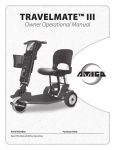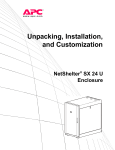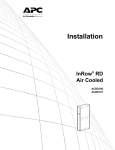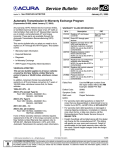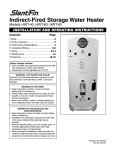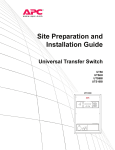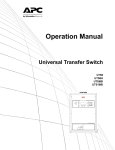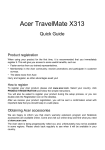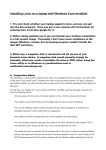Download user manual - Mobility Hire
Transcript
TRAVELMATE™ Owner Operational Manual Serial Number: Read This Manual Before Operating Purchase Date: TABLE OF CONTENTS Safety First 3-4 Location of Controls 4 Identification of Parts 4 Folding/Unfolding Your Amigo 5 Operating Your Amigo 6 Driving Your Amigo 6-7 Safety Warnings 7 Battery Information & Charging Instructions 8-9 Cleaning Instructions 10 Since Amigo Mobility Founder Al Thieme invented the first power-operated vehicle (POV) in1968 for a family member with multiple sclerosis, we have been committed to Improving Lives Through Mobility®. With more than 45 years of mobility expertise, our goal is to bring comfort, freedom and satisfaction to people with mobility challenges. For safe driving, please read this manual carefully before using your Amigo. You will also find helpful hints and tips to help you stay as active as ever. Thank you for choosing the Amigo TravelMate – we hope you enjoy many adventures together! Sincerely, Amigo Mobility International, Inc. (AMI) Maintenance10-11 Troubleshooting/Diagnostic Codes 12 Electromagnetic Interference 13 Wiring Diagram 14 Exploded View 15 Parts List 16 Welcome to our growing family of Amigo owners – we hope you are excited to be part of it! Please return your warranty card to sign up to receive our Friendly Wheels enewsletter. The monthly newsletter features mobility news, inspiring stories and accessible travel tips, written especially for Amigo owners! It will also keep you informed about new products, accessories, helpful hints and service tips. Warranty17 TRAVELM ATE Improving Lives Through Mobility® Since 1968 AMI is not responsible for any damage or injury incurred due to the improper or unsafe use of the POV. AMI specifically disclaims responsibility for any bodily injury or property damage that may occur during any use, which does not comply with applicable federal, state or local laws or ordinances. SAFETY FIRST For your convenience and understanding, signal words are defined below: WARNING IS USED TO INDICATE THE PRESENCE OF A HAZARD, WHICH CAN CAUSE SEVERE PERSONAL INJURY, DEATH OR SUBSTANTIAL PROPERTY DAMAGE IF THE WARNING IS IGNORED CAUTION IS USED TO INDICATE THE PRESENCE OF A HAZARD WHICH WILL OR CAN CAUSE MINOR PERSONAL INJURY OR PROPERTY DAMAGE IF THE WARNING IS IGNORED Safety Guidelines Use the following guidelines for the safe operation and use of your Amigo. Should you have any questions about the safe operation of your vehicle, please contact AMI. If you are in doubt about your ability to operate your Amigo, consult your personal physician. • Read the operating manual before using your Amigo. • Always turn your Amigo OFF before getting on or off your vehicle. • Always remain seated while the vehicle is in operation. • Keep legs on the platform while driving. • Allow the Amigo to come to a complete stop before attempting to reverse. • Always drive at a slow, sensible speed while around pedestrians. • Drive slowly while turning. • Always drive straight up and down inclines. • Avoid sudden starts while the tiller is turned sharply. • Always approach obstacles at a low speed. • Be aware of mechanical pinch points, especially when folding, assembling and disassembling your Amigo. • Remove battery case before folding tiller down. • Always be careful when maneuvering on inclines or ramps. Not all ramps are constructed according to federal standards. The federal standard for wheelchair ramps is 1 inch (2.5 cm) rise per 12 inches (30 cm) = 5 degrees or 8% grade. DO NOT • Do not exceed the maximum weight capacity of 250 pounds (113 kg). Exceeding the weight capacity voids your warranty and may result in personal injury and damage to your Amigo. Amigo Mobility will not be responsible for injuries and/or property damage resulting from failure to observe weight limitations. • Do not drive over or off obstacles more than 1 inch (2.5 cm) high. This could be unsafe and could damage your Amigo. • Do not reverse down a steep hill or incline. • Do not park on inclines or declines. • Do not sit on the Amigo in a moving vehicle. • Do not allow anyone to ride with you. • Do not operate your Amigo near stairs, steps, curbs or terraces where you might accidentally drop a wheel off the edge. • Do not operate your Amigo on streets or other areas with vehicular traffic. • Do not use the tiller to assist in transferring. • Do not lift rear section of platform by holding the rear wheel. • Do not expose your Amigo to spray-on cleaning solutions and excessive moisture such as spraying it with a garden hose, shower or leaving it uncovered in heavy rain. www.myamigo.com 3 LOCATION OF CONTROLS Twist grip handle A. Throttle B. ON/OFF key switch C. Battery gauge D. Reverse indicator light E. Forward/reverse switch F. Horn G. Speed range switch H. Battery connector plug A C G R F F D E B H IDENTIFICATION OF PARTS TRAVELM ATE 6 2 1. Battery case 1 2. Tiller 3. Hub motor 4. Rear wheels 5. Platform 6. Seat 7. Seat adjustment handle 7 8. Tiller release foot pedal 8 9. Freewheeling lever 1 0. Bumper/lifting handle 5 3 4 10 9 9 FOLDING/UNFOLDING YOUR AMIGO Folding REMOVE KEY AND BATTERY CASE BEFORE FOLDING Folding 1. Remove basket. 2. Disconnect battery using the black battery connector plug. Firmly grip handle and lift straight up to unplug (Figure 1). Note: gripping and lifting only the end of the handle will not unplug the battery connection. 3. Lift battery and tilt forward to remove (Figure 2). 4. A spare battery pack is easily stored under the seat with retainer cord. If you are storing a spare battery, lift retainer cord up and over the top of the battery to release. Remove battery from storage area before folding (Figure 3). 5. Lift seat adjustment handle and lower seat onto platform (Figure 4). 6. While holding top of tiller, step on tiller release foot pedal (Figure 5). Push tiller down to rest on seat (Figure 6). To lock tiller in place, loop retainer cord over black knob on top of tiller (Figure 7). Unfolding 1. Remove retainer cord from black knob. 2. Raise tiller until you hear the lower latch click and lock into place. 3. Raise the seat adjustment handle and pull seat up (Figure 4). 4. Reposition spare battery pack by placing under seat. Lift retainer cord up and over the top of the battery to hold in place (Figure 3). 5. Reinstall battery case, then power connection, followed by basket. Insert key. Figure 1 Figure 4 Figure 3 Figure 2 N TIO R E LEVE LEAS LY ATE RE OT ON OPERWITH FO CAU Figure 5 Figure 6 Figure 7 www.myamigo.com 5 OPERATING YOUR AMIGO 1. Turn the Amigo ON with ON/OFF key switch located on the right side of the handle enclosure. F 2. Handlebar directions: a.To move forward, red directional control button near the right hand grip should be in the (F) position. b.Twist right hand grip toward you to accelerate. Hold at desired speed. c. Release grip to stop. d.To reverse, push directional control button to the (R) position, then twist the hand grip toward you as you would to move forward. The indicator light on the console will be 'on' when the switch is in reverse. R F Forward position R 3. The round speed switch on the left side of the enclosure (Figure 6) engages full speed and allows a maximum speed of 4 mph (6.4 kph). When full speed is engaged, the button will have a red edge. Push the top of the switch in to return to normal speed of 3 mph (4.8 kph). ALWAYS SLOW TO A SAFE SPEED BEFORE TURNING. Reverse position Speed range switch Figure 6 4. In the unlikely event you lose power, the drive can be put in freewheeling mode. Twist the freewheeling lever (located on the right side of the front wheel, figure 7) into vertical position. Some resistance while pushing in freewheeling mode is normal. To resume power mode, twist lever back to horizontal position. Before driving, ensure tiller is locked in an upright position. PUSH TOO FAST (PTF) FEATURE PTF feature is intended as a safety measure to prevent “run away” situations, when in freewheeling mode. The faster the Amigo is pushed (forward or reverse), the more resistance is felt. Speed, not distance, engages PTF. Freewheeling lever Figure 7 1. TURN KEY SWITCH TO "OFF" WHEN GETTING ON OR OFF THE AMIGO 2. DO NOT RIDE THE AMIGO WHILE IN FREEWHEELING MODE 3. PUSH FREEWHEELING LEVER TO HORIZONTAL POSITION BEFORE RESUMING NORMAL USE OR TRANSFERRING ON/OFF VEHICLE. DRIVING YOUR AMIGO Normal (horizontal) Freewheeling (vertical) Steering the Amigo is easy and logical. Give wide clearance when turning so the rear wheels clear any obstacle. Shortcutting a sidewalk corner can cause the back wheel to go off the sidewalk. Avoid this situation by steering an exaggerated wide arc around the obstacles. If you must steer in a tight spot, such as entering a doorway or when turning around, stop and then apply power gently. TURNING THE KEY SWITCH OFF WHILE IN MOTION WILL BRING THE AMIGO TO A CONTROLLED STOP Driving through doorways Approach an unfamiliar door slowly. Does it have a knob or push bar? Does it open toward you or away from you? Think in terms of using the power of the Amigo to do the work for you. Hold the doorknob or bar in one hand and apply the power with the other hand. If the door is self-closing, you can go through allowing the door to close behind you. If it is not a self closing door, stop when you are clear of the door and push it closed. If the door opens toward you, hold the knob or bar with one hand and slowly accelerate in reverse, letting the Amigo do the work for you. When the door is open wide enough, accelerate forward leaving your hand on the door to keep it free from touching the Amigo and letting go as you pass through the door jamb. 6 1-800-248-9131/ 989-777-0910 Driving on ramps With the ADA (Americans with Disabilities Act), buildings require ramps for POV (power-operated vehicle) access. Some have U-turns in the middle where good cornering is required. Take wide swings with your front wheel around any tight corners so the rear wheels follow a wide arc to stay clear of the corner. When you have stopped while facing uphill, starting up again simply requires that you apply forward power. Accelerate gently after stopping on an incline. When proceeding up a ramp or curb, lean forward in your seat for maximum stability and safety. Drive slowly when going down any ramp or hill to ensure a safe descent. TRAVELING WITH YOUR AMIGO Transport Amigos are not designed or tested for use as seats in private or public transporting vehicles. Do not transport POVs in vehicles unless folded and placed in the trunk of a car, or placed in the vehicle and strapped down. Even when strapped down, Amigos should not be used as seats in private or public transporting vehicles. USE A SMALL PIECE OF CARPET OR A HEAVY DUTY TOWEL ON VEHICLE BUMPER WHEN LOADING THE AMIGO INTO THE TRUNK OF A VEHICLE TO PREVENT MARKING OR SCRATCHING OF VEHICLE FINISH. To transport your Amigo TravelMate, please refer to page 5 for folding/ unfolding instructions. Airline travel Special handling tags are suggested when transporting your Amigo by airlines. Nonspillable, sealed batteries are approved for travel on airplanes. When you make your reservation, notify the airline that you will be requesting escort service. This will assure that your Amigo will be picked up and delivered at the boarding gate. For additional helpful hints for airline travel, visit our website at www.myamigo.com. *Optional lithium batteries require you to take battery pack onboard plane as carry-on luggage. Public transportation When utilizing public transportation, do not sit on your Amigo while it is being lifted onto the vehicle or once the vehicle is in motion. SAFETY WARNINGS The driving performance of your Amigo can be influenced by electromagnetic fields, such as those emitted by cell phones and other devices. We recommend the power on your unit be switched off when using such a device. • In some extreme circumstances, your Amigo’s performance could be affected by the electromagnetic field emitted from alarm systems in shops (refer to page 13 for additional information). • The program settings in the controller should only be altered by factory-trained service providers in order to maintain safe driving functions. www.myamigo.com 7 BATTERY INFORMATION AND CHARGING INSTRUCTIONS Charging frequency • Charge batteries daily when the Amigo is used. • If not in use for a long period of time, charge for 24 hours, every 30 days. • Extended charging is good for the batteries and will not overcharge them. Battery information For maximum range and life, it is recommended to fully charge the batteries before using. Amigos have an overcharge protection feature, so charging at every opportunity is encouraged. It is a common misconception that batteries should be deeply discharged before recharging – this is not true for Amigo batteries. Batteries may be damaged if they are deeply discharged and left sitting. Battery range depends on driver weight, terrain, temperature and type of battery used. Charge your batteries daily and make sure the charger cord is unplugged from the wall outlet before moving your Amigo. Batteries need charging if the battery indicator light is blinking while operating or if the battery gauge drops to two bars or less. Your battery indicator light may blink prematurely when under a heavy power demand such as an incline. If it is premature, it will stop blinking when the unit is stopped, and the power switch is cycled to OFF and back ON. If this cycle does not stop the blinking, it is time to recharge. Charging instructions Charging a connected battery A charging socket is located on the right side of the enclosure near the throttle, allowing the battery to be charged while connected to the TravelMate. Plug the round end of the charger into the socket, and plug the AC cord into a wall outlet. Charging a disconnected battery If the battery has been removed, plug the round end of the charger into the socket on top of the battery case, and plug the AC cord into a wall outlet. The charging status is indicated by an indicator light on the charger. The light will glow ORANGE or RED to indicate charge is in progress. When batteries are fully charged, the light will switch to GREEN. The battery charger is designed to accept 90-240 volts 50 or 60Hz AC power input. This makes it possible to charge on any AC electrical system globally. 8 1-800-248-9131/ 989-777-0910 FAILURE TO FOLLOW THESE SAFETY INSTRUCTIONS MAY RESULT IN PERSONAL INJURY OR PROPERTY DAMAGE. IF YOUR BATTERIES ARE DAMAGED AND A LEAK IS APPARENT, CALL YOUR AUTHORIZED DEALER IMMEDIATELY. UNDER NO CIRCUMSTANCES SHOULD YOU TOUCH THE BATTERIES IF THEY ARE LEAKING. TO AVOID DAMAGE TO BATTERIES DURING STORAGE, DO NOT PLACE THEM END-TO-END WITH THE POSITIVE (+) AND NEGATIVE (-) TERMINALS NEXT TO EACH OTHER (FIGURE 6). Charger standard precautions • Each time you use your charger, read and follow instructions exactly. Working in the vicinity of a battery is dangerous. Batteries generate explosive gases during normal battery operation. • Never smoke or allow an open flame in the vicinity of the battery. • Use charger for charging a 24-volt lead acid or lithium battery pack only. It is not intended to supply power to an extra-low-voltage electrical system or to charge dry cell batteries. • Do not operate charger in a closed-in area or restrict ventilation in any way. • A spark near the battery may cause explosion. To reduce risk of spark: • Prevent external damage to AC and DC cords. • When connecting charger, connect DC charging cord to the battery charge plug before connecting charger AC cord to electrical outlet. • When disconnecting charger, always do so in reverse sequence of connecting procedure. Break first connection as far away from battery as possible. • Be cautious not to drop a metal tool onto the battery. • Remove jewelry before handling charger. Battery storage If you remove your batteries from the battery case, put them on a surface that cannot be damaged by acid fumes. Whenever a battery is charged and discharged through a cycle, it breathes. The breathing of the battery emits acid fumes and may mark surfaces it rests on for long periods of time. Store batteries indoors in a dry environment, away from any open flames. Temperature range is 0˚C (32˚F) to 40˚C (104˚F). Figure 6 www.myamigo.com 9 CLEANING INSTRUCTIONS Tires: The tires should be cleaned with ordinary kitchen-type cleaners and a damp cloth. Don’t use solvents on tires as they cause tire material to break down or become too soft. Platform: The platform of the Amigo is constructed of aluminum and coated with a durable automotive type finish. Use cool water with mild soap to remove dirt and oils. Do not spray the entire vehicle with water. The platform may be waxed with car body wax and buffed by hand with a soft cloth. Seat: The vinyl seat can be cleaned with a mild soap or detergent and a damp cloth. A vinyl cleaner can also be used. Care should be taken not to soak seats, as the interior foam rubber will hold water. Floor mat: The floor mat should be cleaned with ordinary kitchen-type cleaners and a damp cloth. Do not use solvents on the floor mat, as they may cause the floor mat material to break down. KEEP CLEANING SOLVENTS AWAY FROM ELECTRICAL WIRES AND CONNECTIONS. MAINTENANCE Minimum maintenance should prevent unnecessary repairs. Check the following: Daily • Charge batteries daily when the Amigo is used. Charge the batteries until fully charged to ensure proper battery operation. Monthly Monthly • Check and clean battery terminals and the wire connections as needed with a light piece of emery cloth or brush and soda water. • Inspect batteries for any cracks or damage of any kind. • Check and tighten any exposed fasteners. • Check static ground wire located under vehicle. Replace if damaged or missing. Wire must be in contact with the floor when operating vehicle. Six months • Check all screws and clips (that are holding wheels) for tightness and wear. • Check all electrical connections for clean contact. • Charging connection should be inspected for tight connection. • Check tires for wear. • Inspect inside the battery case, particularly at the bottom, for liquid. Yearly • Have your authorized service center check your Amigo completely. 10 1-800-248-9131/ 989-777-0910 Battery maintenance VRLA (Valve Regulated Lead Acid) deep cycle or optional lithium-ion batteries are used for operating your Amigo. They are maintenance-free and are transportable on aircraft, buses, trains, etc. as there is no danger of spillage. By following the charger and battery procedures, you can expect extended battery life. Fasteners replacement 10.9 Use only Grade 8 (US) or 12.9 DIN (metric) in all applications. For service and replacement parts, we recommend Amigo authorized parts. Microprocessor controller (MPC) Do not attempt to service the MPC or related electronic components, as this will void the warranty. Circuit breaker replacement instructions An automatic resetting circuit breaker protects the wiring and battery in the event of a short circuit. If your Amigo stops abruptly, wait 10 seconds for the circuit breaker to reset. If the breaker does not reset, check for overloads or short circuits. If you suspect the circuit breaker is defective, use a jumper wire between the two terminals of the breaker. If the Amigo runs now, replace the circuit breaker. Battery replacement NOTE: Replacement battery must meet passenger and cargo aircraft travel requirements. • Remove four screws as shown and remove battery front cover. • Remove the black wire from battery. • Remove the white wires from each battery. Automatic resetting circuit breaker Part number 7441 PartNumber7441 • Remove the red wire from battery. • Lift batteries out of case. • Reverse this sequence to install batteries. 7773 6427 10346 9676.11 www.myamigo.com 11 DIAGNOSTIC CODES Diagnostic light locations The Amigo is equipped with a microprocessor controller. This controller has a built-in diagnostic feature that will cause diagnostic light LEDs (located on either side of the battery gauge) to flash a numeric code indicating service issues to aid in diagnosis. When indicating a service problem, the diagnostic light LEDs will flash, hesitate for a moment, and then flash again. Follow the code listings below to determine the problem. If the code indicates a service problem, contact your local service representative or call the Amigo service department at (800) 248-9131 for instructions to verify and correct the problem. * *Note: First solution listed for each diagnostic code will fix that problem 80% of the time. Attempt solutions in the order listed. CODE CAUSE POSSIBLE SOLUTIONS (1) (2) (3) (4) Unplug unit and plug back in Check brake wiring and connections Disconnect brake and cycle key. If code changes to 1-2, replace hub motor Replace MPC controller (1) (2) (3) (4) Unplug unit and plug back in Check brake wiring and connections Replace hub motor Replace MPC controller 1-1 EM Brake windings or connections are shorted 1-2 EM Brake windings or connections are open 2-1 Motor windings or connections are shorted (1) Check motor wiring and connections (2) Disconnect motor wires and cycle key, if code changes to 2-2, replace hub motor (3) Replace MPC controller 2-2 Motor windings or connections are open (1) Check motor wiring and connections (2) Replace hub motor (3) Replace MPC controller 2-3 Power relay short (1) Check/replace batteries (2) Check/replace MPC controller 3-1 Over temperature condition (1) Allow unit to sit idle for 15 minutes, restart and see if code disappears (2) Ensure EM brake and/or motor is not causing excessive amperage draw (3) Replace MPC controller 4-1 Charger is supplying too much voltage during the battery charge cycle (1) Replace battery charger if voltage is 32 volts or higher (2) If 31 volts or lower, replace MPC controller 4-2 Charger not dropping back into "float mode" during battery charging cycle (1) Replace charger wiring (2) Replace battery charger (3) Replace MPC controller 5-1 MPC drive FETS shorted (1) Replace MPC controller 5-2 MPC regenerative braking FETS shorted (1) Replace MPC controller 5-3 Throttle potentiometer or throttle circuitry in fail band fault (1) Check to ensure throttle cable is in good condition (2) Check that throttle moves freely and returns to neutral (3) Replace throttle Requires software revision (1) Replace MPC controller MPC not limiting the electrical current to the motor (1) Replace MPC controller 5-4 5-5 ELECTROMAGNETIC INTERFERENCE RADIO WAVE SOURCES MAY AFFECT POWER-OPERATED VEHICLE (POV) CONTROL. FOLLOW THE WARNINGS LISTED BELOW TO MINIMIZE YOUR RISK TO EMI. The driving performance of your Amigo can be influenced by electromagnetic fields, such as those emitted by cell phones and other devices. We recommend the power on your unit be switched off when using such a device. Electromagnetic interference (EMI) from radio wave sources Powered vehicles may be susceptible to electromagnetic interference (EMI), which is interfering electromagnetic energy emitted from sources such as radio stations, TV stations, amateur radio (HAM) transmitters, two-way radios and cellular phones. The interference (from radio wave sources) can cause the powered vehicle to release its brakes, move by itself, or move in unintended directions. It can also permanently damage the powered vehicle’s control system. The intensity of the interfering EMI energy can be measured in volts per meter (V/m). Important information 1. 20 volts per meter (V/m) is a generally achievable and useful immunity level against EMI (as of May 1994). The higher the level, the greater the protection. 2. The immunity level of this product is not known. 3. In some extreme circumstances, the Amigo's performance may be affected by the electromagnetic field emitted from alarm systems. 4. The program settings in the controller should only be altered by factory-trained service providers in order to maintain safe driving functions. The sources of radiated EMI can be broadly classified into three types 1. Handheld portable transceivers (transmitters-receivers) with antenna mounted directly on the transmitting unit. Examples include: citizens band (CB) radios, security, police transceivers, cellular telephones and other personal communication devices. Note: Some cellular devices transmit signals while they are ON, even when not in use. 2. Medium-range mobile transceivers, such as those used in police cars, fire trucks and taxis - usually have the antenna mounted on the outside of the vehicle. 3. Long-range transmitters and transceivers, such as commercial broadcast transmitters (radio and TV broadcast antenna towers) and amateur (HAM) radios. Note: Other types of handheld devices, such as cordless phones, laptop computers, radios, TV sets and small appliances such as electric shavers and hair dryers are less likely to cause EMI problems. Powered vehicle electromagnetic interference (EMI) Because EMI energy rapidly becomes more intense as one moves closer to the transmitting antenna (source), the EMI fields from handheld radio wave sources (transceivers) are of special concern. It is possible to unintentionally bring high levels of EMI energy very close to the powered vehicle’s control system while using these devices. This can affect powered vehicle movement and braking. Warnings Follow the warnings listed to reduce the chance of unintended brake release or mobile vehicle movement, which could result in serious injury. 1. DO NOT operate or turn ON handheld personal communication devices, such as citizens band (CB) radios and cellular phones while the vehicle is turned on. 2. Be aware of nearby transmitters, such as radio or TV stations, and avoid close proximity. 3. If unintended movement or brake release occurs, turn the vehicle off as soon as it is safe. 4. Adding accessories or modifying the vehicle may make it more susceptible to interference from radio wave sources. Note: There is no easy way to evaluate their effect on the overall immunity of the vehicle. 5. Report all incidents of unintended movement or brake release to the vehicle manufacturer, noting whether there is a source of EMI nearby. www.myamigo.com 13 TRAVEL MATE 580003 (WIRING DIAGRAM) FEBRUARY 2013 – PRESENT 14 1-800-248-9131/ 989-777-0910 TRAVEL MATE 580003 (EXPLODED VIEW) FEBRUARY 2013 – PRESENT 11568 11507 11569 11517 11311 10050 11508 7600 11504 1193 11505 11592 11502 11501 11557 COLUMNBEARING (NOT TO SCALE) 11534 11481.20 11511.20 11519 11553 11292TM3 10346 11680 11510 11503 1254 11337 11506 11565 10144 4269 1069 11657 11681 STANDARD 11682 LITHIUM 11531 4075 10971 6305 10393 11657 11542 11543 11544 10060 11527 10516 11528 5893 5514 10973.22 10050 9022 5209 11524 11520 3622 11657 11513 11535 6227 11514 11530 11512 1040 11533 11529 11509 10970 11665 9676.11 6699 2315 7773 7441 11522 11666 6427 11515 11657 10151 6304 10134 10346 11521 11681 STANDARDBATTERY ASSEMBLY www.myamigo.com 15 PARTS LIST TravelMate #580003 – February 2013 to Present Part # Description 1040 1069 1193 1254 2315 3622 4075 4269 5209 5514 5893 6227 6304 6305 6427 6699 7441 7600 7773 9022 9676.11 10050 10060 10134 10144 10151 10346 10393 10516 10970 10971 10973.22 11292TM3 11311 11337 11481.20 11501 11502 11503 11504 11505 11506 11507 Ring, Retaining 5/8 OD Shaft Washer, Shim, 5/8 ID x 7/8 OD x .016 Thk Screw, Hex, 1/4-20 x 3/4 Lg Pin, Spring, 1/8 OD x 1 1/8 Lg Nut, Hex, Nylon Insert, #4-40 Nut, Hex, Nylon Insert, 1/4-20 Screw, Flat Head Hex Socket, 1/4-20 x 2 Lg Washer, Flat, 5/8 ID x 1 1/8 OD Cap, Wheel, Black Screw, Hex, 1/4-20 x 2 3/4 Lg Washer, Flat, 9/32 ID x 1 OD Nut, Hex, Nylon Insert, #10-24 Velcro Dual Lock 400/In Velcro Dual Lock 170/In Wire Asm Battery to Circuit Breaker Screw, Phillips, #4-40 x 1/2 Lg Circuit Breaker, Auto Reset, 25 Amp Nut, Push, 1/4 Stud Cap, Vinyl Insulated Washer, Nylon Shim, 3/8 ID x 11/16 OD x .02 Thk Battery, 12 Volt, 9 Ah Bearing Set Nut, Hex, Heavy Walled, 1/4-20 Wire Asm Battery to Power Connector Wire Asm Battery to Controller Foam Insert, Adhesive Backed Screw, Phillips, #8 x 3/4 Lg Type B Ground Wire Asm Boot, Lower Handle Velcro Loop Velcro Hook Basket Asm Controller Travel Mate 3 Washer, Lock, 1/4 ID Washer, Flat, 13/64 ID x 1/2 OD Band, Retaining, Handle Arm, Front Seat Mount Arm, Rear Seat Mount Shaft, Short, Seat Pivot Shaft, Long, Seat Pivot Spring, Extension Axle, Rear Seat, Folding Vinyl 16 1-800-248-9131/ 989-777-0910 Qty/unit 2 4 4 1 2 1 2 2 2 1 1 3 1 1 2 2 1 2 2 2 2 1 2 1 1 4 8 1 1 3 3 1 1 4 2 1 1 1 3 1 2 1 1 Part # Description 11508 11509 11510 11511.20 11512 11513 11514 11515 11517 11519 11520 11521 11522 11524 11527 11528 11529 11530 11531 11533 11534 11535 11542 11543 11544 11553 11557 11565 11568 11569 11592 11657 11665 11666 11680 11681 11682 Latch, Seat Adjusting Mat, Standard Cover, Handle Front Cover Asm, Handle Rear Pivot Weldment, Steering Pivot Weldment Handle Link, Handle Latch Bumper, Front Wheel Bracket Asm, Seat Upper Throttle, Twist Grip Wire Asm Motor Motor, Hub 8" w/ EM Brake Fork Weldment, Motor Wheel Asm, Rear 9" Screw, Shoulder, #10-24 x 1 Lg Screw, Shoulder, #10-24 x 1 1/2 Lg Screw, Shoulder, 5/16-18 x 1/4 Lg Spring, Compression 3/4 OD x 1 Lg Nut, U-Spring #8 Screw Screw, Set, 5/16-18 x 5/8 Lg Ring, Retaining 1/2 OD Shaft Wire Asm Brake Platform Pacific Blue Platform Cinnamon Red Platform Lime Green Wire Asm, Cntrl/Display Ring, Spiral Handle Grip Seat Cover, Back Seat Cover, Bottom Spacer, Plastic, 1/4 ID x 1/2 OD x 3/4 Lg Kit Trim Travel Mate 3 Battery Case Battery Cover Handle Weldment Battery Case Asm Standard Battery Case Asm Lithium Qty/unit 1 1 1 1 1 1 2 1 1 1 1 1 1 2 1 2 2 1 4 1 8 1 1 1 1 1 2 1 1 1 2 1 1 1 1 1 1 AMIGO MOBILITY - HEALTHCARE DIVISION General Warranty Provisions Amigo Mobility International, Inc. (AMI) warranties the original, completed Amigo it manufactures only to the original owner. If warranty card or proof of purchase is not received, warranty begins on the date the Amigo was shipped. The warranties on this page do not cover the failure of any part or accessory due to: • Shipping damage • Abuse, misuse, accidental damage, or acts of nature • Exceeding the specified weight capacity of the model • Improper installation or opening sealed components • Modifying the Amigo or installing accessories not authorized by AMI Warranty Coverage: AMI will repair or replace a part that is defective in material or workmanship under normal use. AMI may use factoryremanufactured parts (rather than new parts) for some warranty repairs. Warranty replacement parts are covered for the remainder of the Amigo unit warranty. AMI covers labor warranty at factory headquarters in Bridgeport, MI for the first 60 days of ownership. Freight charges are not included under labor warranty. • Structural components – platform, frame and seat post have a limited lifetime warranty (seven years). • Main components – controller, charger, motor and transaxle have a two-year warranty. • Seats and other components have a one-year warranty (cuts and tears in seats are not covered by warranty). • Batteries supplied by AMI are warranted for one year (freight not included after six months) and carry Amigo brand labels. - Damage caused by battery moisture, spillage, or leakage is exclusive of warranty. - Note - Lithium-ion batteries carry the following warranty: 1) Warranty period is 60 months; beginning when the Amigo healthcare model or batteries are shipped from AMI factory. Serial number of unit/date code on battery will be required. 2) Warranty covers defects in workmanship and material. 3) Failure constitutes a fully recharged battery with less than 50% of its rated capacity under normal operating/ charging conditions and is covered within the 60 month period. 4) Lithium-ion batteries must be returned to AMI. Upon receipt, batteries will be tested to confirm warranty conditions are met. 5) First 36 months’ replacement batteries will be lithium-ion; 37 months and older may receive sealed lead acid batteries. • AMI is obligated to repair or replace products/parts returned by the purchaser and found to be defective under warranty at our factory in Bridgeport, Michigan. • If inspection determines that a returned part or unit is fully functional or inoperable due to a non-warranty nature, it will be returned at expense of the owner. • Parts purchased separately from the original unit, or rebuilt units, carry a one year warranty against defects in material and workmanship. Customer Satisfaction: Complete satisfaction with your Amigo is our main goal. If you are not satisfied with any maintenance or repair work completed by a local Amigo dealership, please follow these two steps: Step 1 – Review your concerns with the dealership’s management (service manager or general manager). In most cases, a satisfactory solution is found. Step 2 – Occasionally, an Amigo owner will not be fully satisfied with a dealer’s decision or actions. In that case, contact Amigo customer service at 1-800-248-9131. Having the following information available will expedite response time: • Serial number of your Amigo • Name of dealer who sold you the Amigo (city and state) • Date and reason for each visit to dealership This warranty supercedes and is in lieu of all other warranties, expressed or implied, and no person, agent or dealer is authorized to give any warranties on behalf of AMI, nor to assume for AMI any other liability concerning any of its products unless made in writing and signed by an official of AMI. This warranty gives you specific rights, with the possibility of other rights, which vary depending upon your locality. www.myamigo.com 17 NOTES NOTES H1322011 AMIGO MOBILITY INTERNATIONAL, INC. Improving Lives Through Mobility® 6693 Dixie Highway, Bridgeport, MI 48722-9725 Service: 800-248-9131 or 989-777-0910 • Fax: 800-334-7274 • www.myamigo.com © 2014 Amigo Mobility International, Inc. Amigo® is a trademark of Amigo Mobility International, Inc • 0114-11659RevD




















